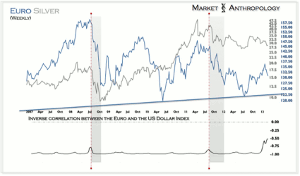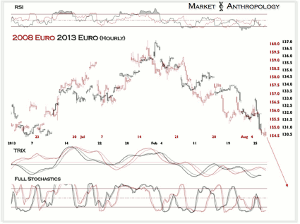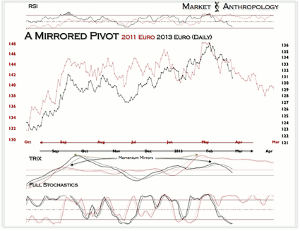In recent months, we have seen strength in the euro, weakness in the US dollar, but not the usual rally in precious metals that normally goes with this scenario, and Erik Swarts of MarketAnthropology.com gives a preview of what to expect in the next few weeks.
To put it mildly, there are some interesting kinetics developing in the currency markets these days. And although the Monday morning pundits will point to XYZ to fit their respective bylines, the truth is these currency moves—the euro, Aussie, the US dollar to name a few; have been building for quite some time. We should know, we have eagerly watched their potential energies build beneath the surface. It is why we had expected a binary environment in the currency and commodity markets—as tensions built in momentum and relative strength divergences and lulls in historic correlations. With considerable process to interpretation—rather than reaction, we find ourselves driving the train rather than colliding with it.
A few things to consider here:
We would caution against relying on oversold RSI readings, sentiment, and COT reports—to position mean reversion strategies in this kind of environment. Look no further than the recent action in the Japanese yen and the precious metals miners for examples of the inertia behind these moves. You typically find strongly oversold conditions develop on an hourly and daily basis and replicate through to the weekly measure over time. To a degree, we expect similar dynamics to develop in silver, gold, the euro, and the Aussie over the coming weeks.
Of the previous two occasions where the euro:US dollar index exhibited a pronounced drop in the historic correlation—the return trip to "normalcy" was commensurate to the size of the "signal." Both occasions marked exhaustion for the euro—and the asset river that runs through it (see Here). Also, on both occasions (8/08 & 9/11), silver failed quite dramatically over a relatively short timeframe.
Downstream, we expect the ledge support for the euro extending from November 2005—to fail in this decline and add further downside momentum to the move.
By Erik Swarts, Trader & Blogger, MarketAnthropology.com





















